Electromagnetic waves in the Earth's magnetosphere
Electromagnetic waves play a key role in the energy transfer in the collisionless plasma environment of the Earth’s inner magnetosphere. Specifically, they are responsible both for the energization and losses of energetic particles trapped in the Van Allen radiation belts, controlling ultimately the trapped particle fluxes. These waves are observed over a wide range of frequencies, from less than 1 Hz up to a few MHz. We focus in particular on the analysis of waves in the extra low frequency / very low frequency ranges (ELF/VLF, frequencies from about 3 Hz to 30 kHz). The waves in this frequency range can interact with energetic particles in a particularly effective way, because their frequencies are not too far from the ion/electron cyclotron frequencies in respective interaction regions. Moreover, the ELF/VLF range is adequately covered by recent spacecraft instrumentation, allowing for extensive experimental studies.

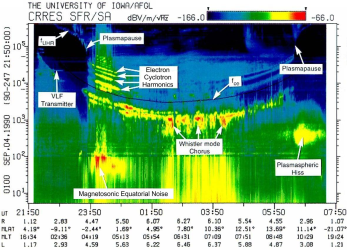
(left) Scheme of important plasma wave locations. (right) Spectrogram of waves observed by a spacecraft. (credit: emfisis.physics.uiowa.edu)
We focus on the experimental analysis of various wave phenomena (natural chorus and hiss emissions, lightning generated whistler waves, waves generated artificially by VLF transmitters and power line harmonic radiation). Our aim is to understand their properties, propagation patterns throughout the Earth’s magnetosphere, and generation mechanisms. Multicomponent multipoint observations are often used to analyze spatiotemporal variability of the observed phenomena.
Space environment around Mars
Martian interaction with the solar wind is fundamentally different than in the case of Earth, as it does not possess a global magnetic field. However, it has a conductive ionosphere, and the magnetic field induced therein due to the draping of the interplanetary magnetic field around the planet effectively prevents the solar wind from getting in its very vicinity. Additionally, the weak crustal magnetic fields may have localized effects further complicating the interaction. The dayside ionosphere of Mars is formed primarily due to the photoionization by incoming solar radiation. The main source of the nightside ionosphere is, apart from the plasma transport from the dayside, the ionization caused by precipitating energetic particles. It is significantly patchier and to a large extent controlled by a configuration of crustal magnetic fields.
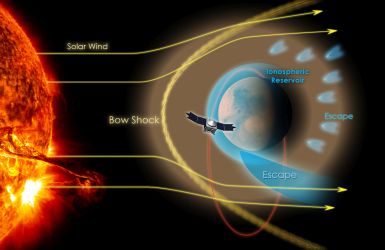
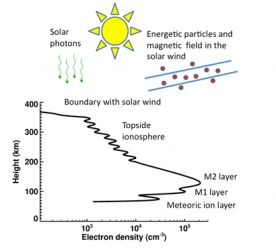
(left) Solar wind interaction with Mars. (right) Formation of the Martian ionosphere. (credit: NASA/GSFC; P. Withers, Boston University)
We focus on the experimental analysis of the plasma and electromagnetic environment of Mars, using both in-situ measured and radar sounding data. A special attention is paid to characterizing the ionospheric electron densities and understanding the role played by the remnant crustal magnetic fields in the global interaction of the solar wind with the planet.
Turbulence in the solar wind
The plasma environment of the solar wind exhibits various phenomena and fluctuations at different spatial scales. At sufficiently large spatial scales, a magnetohydrodynamic (MHD) approximation, describing the plasma as a magnetized fluid, can be effectively employed. At smaller scales, however, one needs to consider kinetic effects related to individual charged particle movements in complex electromagnetic fields. The solar wind environment, along with available in-situ plasma and magnetic field measurements, represents a unique natural laboratory to study relevant turbulent phenomena. It turns out that an energy cascade is formed, transferring the energy from larger to smaller spatial scales, and ultimately resulting in the plasma heating. We focus on using solar wind plasma measurements with unprecedented sampling frequency to understand experimentally the transition between individual characteristic scales.
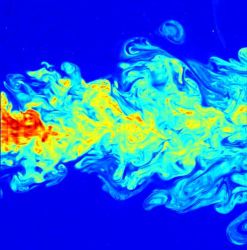
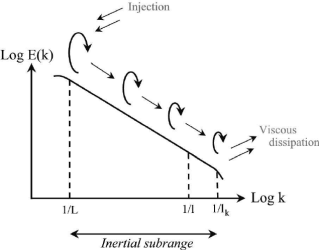
(left) Model turbulence flows. (right) Energy cascade. (credit: Wikipedia)
Solar wind interaction with Earth
Solar wind, a stream of charged particles (primarily protons and electrons, with a few percent of alpha particles), impinges on Earth with flow velocities of about 400 km/s. Considering that low-frequency wave propagation speeds in the respective plasma medium are a few tens of kilometers per second, the solar wind flow is highly supersonic. However, the Earth’s magnetic field prevents the solar wind from getting too close. A pressure balance between the dynamic pressure of the solar wind and the magnetic field pressure of the Earth’s magnetic field is achieved at a boundary called magnetopause. It is a boundary between the Earth’s magnetosphere and the region occupied by the solar wind plasma and the interplanetary magnetic field, i.e., the farthest place where the terrestrial magnetic field reaches. Generally, the location of the magnetopause is not stable, but it moves depending on many different factors, most importantly due to the variations in the incoming solar wind. Considering that the solar wind speed is vastly supersonic, an additional boundary (“bow shock”) is formed upstream the magnetopause, where the solar wind is abruptly slowed down and heated. The region between the bow shock and the magnetopause, filled with this slowed and heated solar wind plasma, is called magnetosheath.
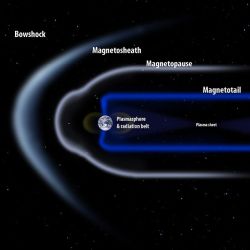
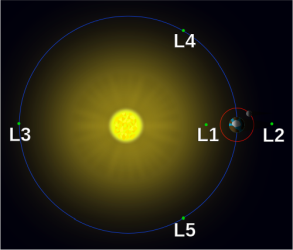
(left) Scheme of the situation. (right) Lagrangian points. (credit: Wikipedia)
A major focus of our research group is to use in-situ measured satellite data in the vicinity of magnetopause and bow shock to better understand the variation of their locations, shapes, and properties on the state of the incoming solar wind. This is determined based on spacecraft monitoring solar wind properties at Lagrangian L1 point, maintaining the same relative position with respect to the Sun and Earth.
|
Last update on 3 October 2019
Bootstrap Sidebar V09, Colorlib, 2022; CC BY 3.0 |